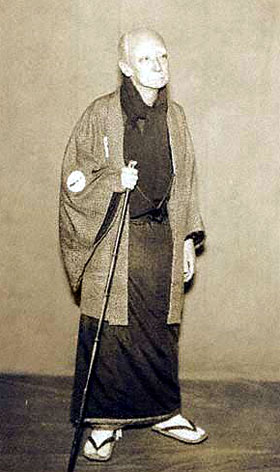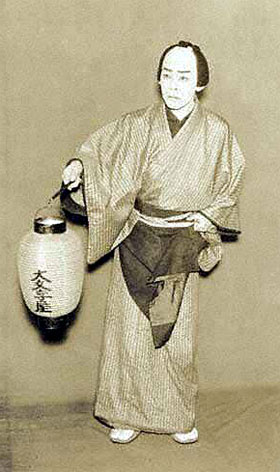| DAIMONJIYA |
| Play title | Kamiko Jitate Ry˘men Kagami Mirror of the Two-Sided Paper Kimono* |
| Author | Suga Sensuke |
| History |
The play "Kamiko Jitate Ry˘men Kagami" was originally written for the puppet theater (Bunraku) and staged for the first time in the 12th lunar month of 1768 in ďsaka. It was adapted for Kabuki 125 years later, in November 1893, in ďsaka at the Naniwaza, starring Kataoka Gat˘ III in the roles of Yorozuya Sukeemon and the bant˘ Gonpachi in the "Daimonjiya scene" [casting]. "Daimonjiya" is rarely-staged on Kabuki stages; since the end of World War II, we've found only 6 records of performances in ˘shibai between 1947 and 1987: |
| Structure |
"Kamiko Jitate Ry˘men Kagami" was originally made up of 3 acts (8 scenes). The "Daimonjiya" scene is in the last scene of the 2nd act of "Kamiko Jitate Ry˘men Kagami". |
| Key words | Bant˘ Gidayű Ky˘gen Giri/Ninj˘ Kamigata Kabuki Kamiko Kataoka Jűnishű Kuruwa Nimaime Sewamono Shinjű Shinjűmono Shinmachi Sukerokumono Tedai Wagoto |
| Summary |
Outside the house of assignation Ukabuse in ďsaka Denkur˘, bant˘ at the Yorozuya, a prosperous antique store, is in league with Inokuma Tanzaemon, a warrior. Tanzaemon's master has previously sold a scroll, a family heirloom, to the Yorozuya store, and Denkur˘ has stolen the scroll and handed it over to Tanzaemon. Their plan is to lay the blame for the theft on Sukeroku, the son and heir of the proprietor of the Yorozuya Sukeemon. If all goes well, Sukeroku will then be disowned by his father and divorced by his wife Omatsu. Denkur˘ will then inherit the business himself and marry Omatsu whom he covets. A further complication is that Sukeroku, despite his marriage to Omatsu, is also deeply involved with the keisei Agemaki, a courtesan from the Shinmachi licensed quarter. Sukeroku hopes to raise the sum of three hundred ry˘ to enable him to buy her contract and release her from the house of assignation to which she is attached. Tanzaemon, who lusts after Agemaki, is eager to buy her himself and hopes to be able to do so once Sukeroku has been discredited as a thief. Their business completed, the two men leave. Agemaki, herself, emerges from the building and sends her companion on an errand. Sukeroku enters via the hanamichi wondering why Agemaki has sent a letter asking him to come and meet her. The two lovers bump into each other and reaffirm their affection for one another. Sukeroku tells Agemaki that, according to Denkur˘ (whom he foolishly trusts), a payment to the ďgiya of one hundred ry˘ will be sufficient to guarantee that she will not be ransomed by any other. Sukeroku says that he has the means of raising the necessary money through Denkur˘. To the great confusion of the young couple, the uncle of Sukeroku, Harada Ryűsuke, arrives and berates his nephew for his scandalous affair with a courtesan. Ryűsuke goes on to advise Sukeroku to pull himself together and break off his relationship with Agemaki so that he can succeed with honor to the ownership of his father's shop. Ryűsuke then leaves. Tanzaemon and Denkur˘ return. Tanzaemon had asked Sukeroku to sell valuable sword guard. The sale of the sword guard for three hundred ry˘ was arranged, and Kinshichi, the dealer, was to bring this money. It had been proposed to Tanzaemon, through Denkur˘, that one hundred ry˘ be loaned to Sukeroku, and this is done. However, Kinshichi had joined forces with Tanzaemon and Denkur˘. Hachizaemon, proprietor of the house of assignation ďgiya, to which Agemaki is contracted, enters and explains that the first person to pay the money, to release her from her contract, will be entitled to the girl. Sukeroku produces the hundred ry˘ and gives them to Hachizaemon who then hands over a receipt before leaving for the ďgiya. Tanzaemon then demands that Sukeroku give him an IOU for the hundred ry˘. But Sukeroku, having no seal or writing brush with him, cannot do so. For this reason Sukeroku has no alternative but to give to Tanzaemon the receipt he earlier received from Hachizaemon. As he intended Tanzaemon has now gained possession of the receipt towards the ransom of Agemaki. Tanzaemon will keep the receipt and pay the remaining two hundred ry˘ and thus make Agemaki his own, Sukeroku will be unable to do anything about it. As they talk, Omatsu, the wife of Sukeroku, then passes by and, noticing her husband, stands listening to the conversation of the two men. Hachizaemon returns saying that the money he received from Sukeroku was counterfeit. Tanzaemon realizes that display has come to nothing so he and Denkur˘ set on Sukeroku who now realizes how the other two had tricked him. Fortunately Ryűsuke returns at that point and comes to Sukeroku's aid by giving him three hundred ry˘ to give back to Tanzaemon. Tanzaemon has no choice to give the receipt back to Hachizaemon who then leaves to discuss the ransom of Agemaki with another client. Chagrined that his own plan to buy Agemaki has come to naught, Tanzaemon also leaves. As Ryűsuke is about to be on his way, one of the maids brings him a bundle that has been left inside. It turns out to contain a kamiko which Sukeroku is made to put on to symbolize his poverty and destitution. Ryűsuke also produces a letter from Sukeroku's father which announces that the young man has been formally disowned. When Ryűsuke has gone Omatsu and Agemaki emerge having overheard everything. Omatsu expresses her feelings of resentment towards the courtesan who has come between herself and her husband. Sukeroku promises that, if he is reinstated by his father, he will break completely with Agemaki. The courtesan also agrees to this and as proof of her sincerity, she gives to Omatsu a treasured comb. Courtesans and servants emerge from the inner rooms and mistake Sukeroku for a beggar. Omatsu and Agemaki leave while Sukeroku is left to ponder his straitened circumstances. At the Daimonjiya Cotton Store in Honmachi Chűbŕ, a tedai at the Yorozuya, announces at the door that Sukeemon, the father of Sukeroku is sending Omatsu back to her parents. This is not altogether a surprise since Eizabur˘, Omatsu's brother, has been advising his mother to call Omatsu back because of Sukeroku's continuing liaison with that keisei from the licensed quarter. Indeed, it seems that Sukeroku intends to install Agemaki in his home in place of Omatsu. Omatsu laments her unhappy situation and the fact that, as it turns out, her husband has run away with Agemaki. Eizabur˘ commiserates with her and makes a surprising suggestion to her that she contracts herself to the ďgiya to compensate for the loss to the proprietor of one of his most popular girls. Feeling that she must try to make up for the irresponsible behavior of her husband, Omatsu agrees. My˘san, her mother, has overheard all this and she comes in at that moment and praises her daughter for her sacrifice. Sukeemon, himself, then arrives and expresses his admiration for the way Omatsu has endured a difficult situation. He produces what seems to be a document finalizing the divorce between Omatsu and Sukeroku but it turns out to be a certificate showing that Sukeemon has paid to the ďgiya the money for the release of Agemaki from her contract. This means that Omatsu will not have to take up the life of a courtesan after all. Sukeemon thanks Omatsu for all she has done for his son and hopes that, if Sukeroku ever does mend his ways, he and Omatsu will be able to resume married life together. Sukeemon leaves but Denkur˘ then arrives with Gonpachi, the Daimonjiya bant˘ with whom he is league. Denkur˘ still covets Omatsu and plans to abduct her. Gonpachi goes into the store to tell Omatsu that Sukeroku (actually Denkur˘ hiding in the dark) is waiting for her outside. Omatsu soon realizes what is going on and the abduction attempt is easily foiled by both My˘san and Eizabur˘. (*) the title "Mirror of the Two-Sided Paper Kimono" comes from "A Kabuki reader: history and performance". |
| Trivia |
Sukeroku, a nimaime in this drama, is performed in the semicomic wagoto style typical of the roles of lovers and heroes in sewamono in ďsaka Kabuki. Traditionally the roles of Yorozuya Sukeemon and the bant˘ Gonpachi are played by the same actor. |
 |
 |
|
The actors Kataoka Nizaemon XI and Nakamura Kichiemon I playing the roles of Yorozuya Sukeemon and Daimonjiya Eizabur˘ in the drama "Kamiko Jitate Ry˘men Kagami", which was staged in October 1931 at the Meijiza |
|
|
|
| Contact | Main | Top | Updates | Actors | Plays | Playwrights | Programs | Links | FAQ | Glossary | Chronology | Illustrations | Prints | Characters | Derivatives | Theaters | Coming soon | News |